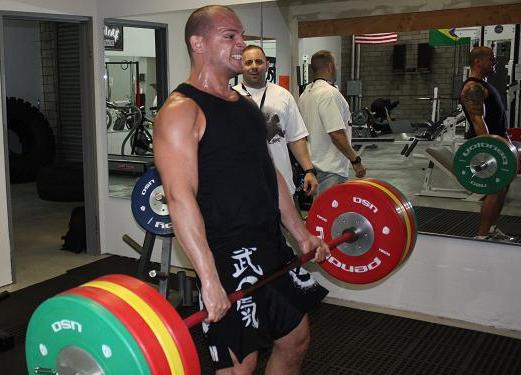Wendler 5/3/1 is a very popular powerlifting program that was developed by powerlifter and strength coach Jim Wendler.
It’s relatively simple. You have four main barbell lifts: overhead press, deadlifts, bench press, and squat. You need to measure your 1 rep max on each 4 lifts and then take 90% of each 1 rep max. You will base your workouts on those new numbers.
In a regular 5/3/1, you’re expected to train three or four days a week. Each workout day is centered around one core lift.
Each training cycle lasts four weeks, with these set-rep goals for each major lift:
Week 1 3 x 5 65%, 75%, and 85% for five reps each + assistance work.
Week 2 3 x 3 70%, 80%, and 90% for three reps + assistance work.
Week 3 3 x 5, 3, 1 75%, 85%, and 95% for five + assistance work.
Week 4 Deload Reduce your loads on the fourth week so the workouts won’t be taxing.
Then increase the 90% max by five to 10 pounds for the next month.
Learn more about 5/3/1 HERE
Many grapplers have used 5/3/1 as part of their training routine. The problem is when you train grappling every day or even 4x a week, it can be difficult to fit in a powerlifting routine in there.

Xande Ribeiro deadlifting
Jim Wendler recently released a new 5/3/1 version specially for MMA fighters and grapplers, with just two strength training sessions a week:
“As with any sport, MMA requires that you are strong in the low back, legs, arms, chest, shoulders and abs. Like all sports, strength is one of many things that need to be trained. This is unlike the strength sports – thus more abilities must be trained and MORE TIME must be spent on them. So you can’t spend all day in the weight room. You have to be efficient in the weight room; you have to choose exercises that mean something and that carry over.
Since there are many abilities that must be trained and much time devoted to practice (and this practice being very difficult), I propose the following.
Train two days/week
Assistance work is kept to 2-3 exercises per day
A third day can be added for additional assistance work (if time and energy allow)
The time spent in the weight room must be devoted to getting stronger, not running around doing circuits. You are in the weight room to get stronger, NOT to mimic another practice. Every time I see someone prescribing conditioning circuits for MMA strength training, I breathe a sigh of relief. As long as this person is deemed an expert, I will always have a job. Feel free to do your battling ropes and burpees AFTER you strength train.
Day One
Squat
Bench Press
Assistance Work
Day Two
Deadlift
Press
Assistance Work
Assistance work should be plenty of lat and upper back work, arm work or anything that you need personally for injury prevention.
Like any sport, the role of the weight room is nothing more than GPP – and the time spent in the weight room FOR ANY ATHLETE is terribly easy (despite what people would have you believe). Get progressively stronger on the basic lifts, don’t lift yourself out of play or practice (i.e. it shouldn’t interfere greatly with practices and definitely not matches). Being sport specific in the weight room is a f*cking gimmick. Even the people that stroke that flaccid idea know it. Please don’t fall for that ridiculous notion. And you don’t need to be strong to be a better athlete, but being stronger than you were is always a good thing. Especially if done progressively, over time and with patience. These are the gains that last and that will hurt your opponent the most.
I cannot stress enough how important it is for a fighter to work with their skill coach/coaches to help them periodize their strength training. This means PLAN. Obviously things change in ALL areas of training depending on how far your competition is. To make it simple, the farther out you are from your fight, the more you can lift (if you need that). The closer you are to the competition, the less you can do. Or to put it even more simple:
Far away from fight: can do more sh*t that makes you tired/sore and effect your skill training.
Closer to fight: you can do LESS sh*t (or none at all) that makes you tired/sore and effect your skill training.
This type of sport periodization was made popular by Siff, Zatsiorsky and Verkhshanksy: it’s called The Common Sense Principle. If your skill coach can’t understand this, I don’t know what to tell you.”
Rolling Strong combines scientific exercises and routines specifically geared towards grappling.
Phil Daru is a performance coach for over 200 Elite Level Fighters in all aspects of combat sports.
Learn a comprehensive approach that covers everything from proper warmups to exercises designed to improve your guard!


















